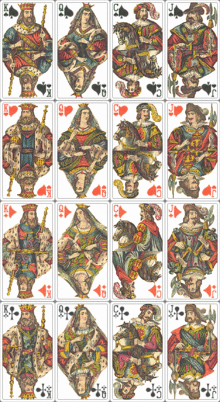Face card

In a deck of playing cards, the term face card is generally used to describe a card that depicts a person as opposed to the pip cards.
Chinese "money cards" do not have a concept of face cards or pip cards. Some suits depict only pips while others only human figures. However, the suits with people rank higher than the pip suits. When playing cards arrived in Persia, the Persians created the distinction between pip and face cards. In their Ganjifeh decks, each suit had ten pip cards that are outranked by the vizier and the king. Cards were transmitted further west where Mamluk Egypt created a third court card. Their court cards didn't show any faces to prevent idolatry.[1] Instead they showed abstract designs or calligraphy for the malik (king), nā'ib malik (viceroy or deputy king), and thānī nā'ib (second or under-deputy).[2] It wasn't until the cards arrived into Europe that illustrators could add human figures again to these cards. Both Mamluk and modern decks include three face cards per suit, or twelve face cards in a deck of four suits.[3]
- Italian and Spanish playing cards have the Fante or Sota (Jack, a younger man standing), Cavallo or Caballo (Knight, a man sitting on a horse) and Re or Rey (King, wearing a crown)
- German and Swiss playing cards similarly have three male face cards per deck, Under/Unter (Jack, a lower-class man or soldier), Ober (a higher clerk), and König (King)
- French playing cards replaced the middle male with the Queen so it became Jack, Queen, and King
French and Latin tarot decks have four face cards per suit. Their order is Jack, Knight, Queen, and King for a total of 16 face cards.
While modern decks of playing cards may contain a Joker (or two) depicting a person (such as a jester or clown), jokers are not normally considered to be face cards. Figures appearing on tarot trumps are also not considered to be face cards.
References
| Wikimedia Commons has media related to Face cards. |
| ||||||||||